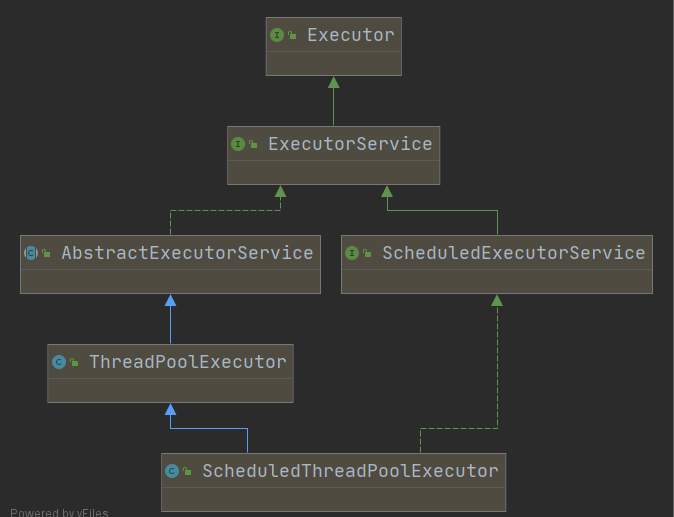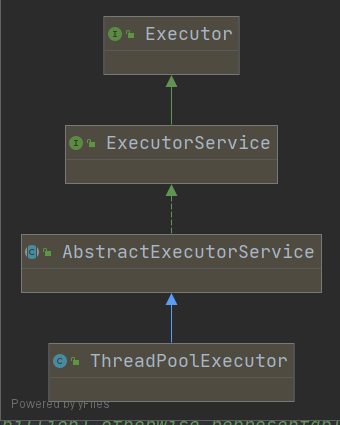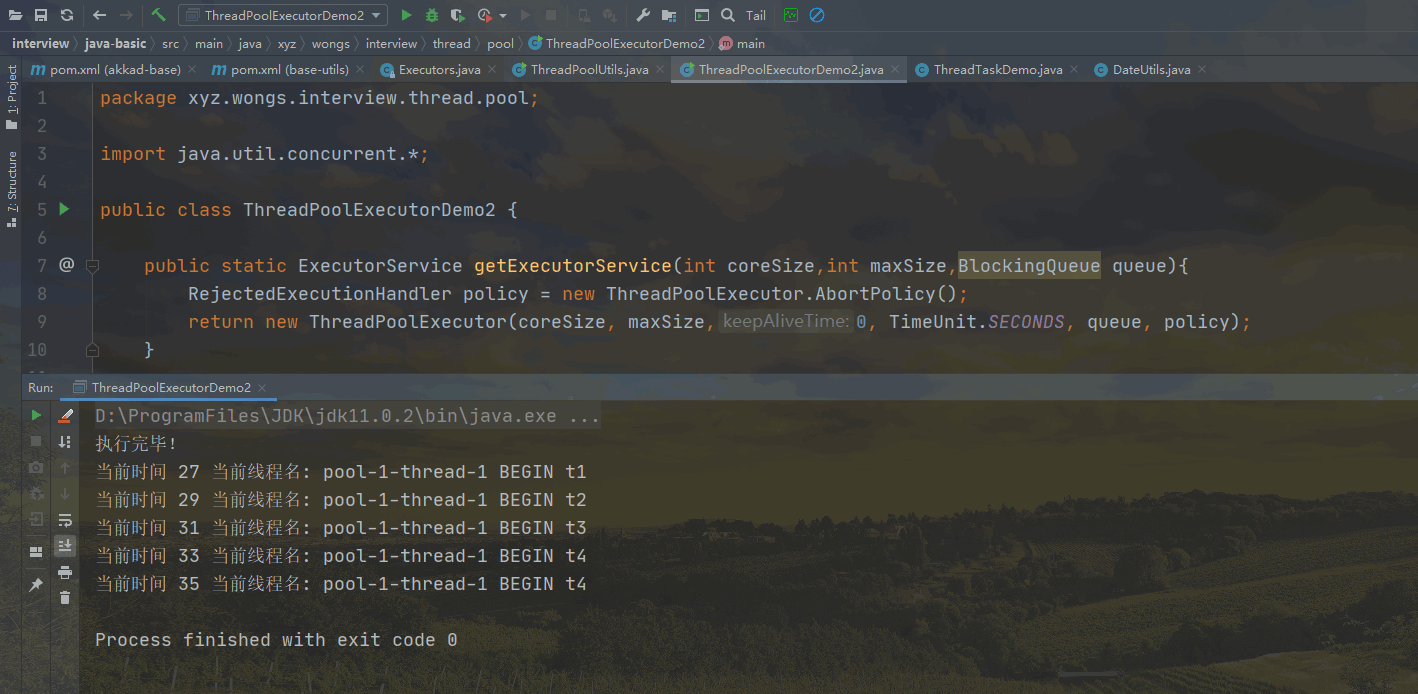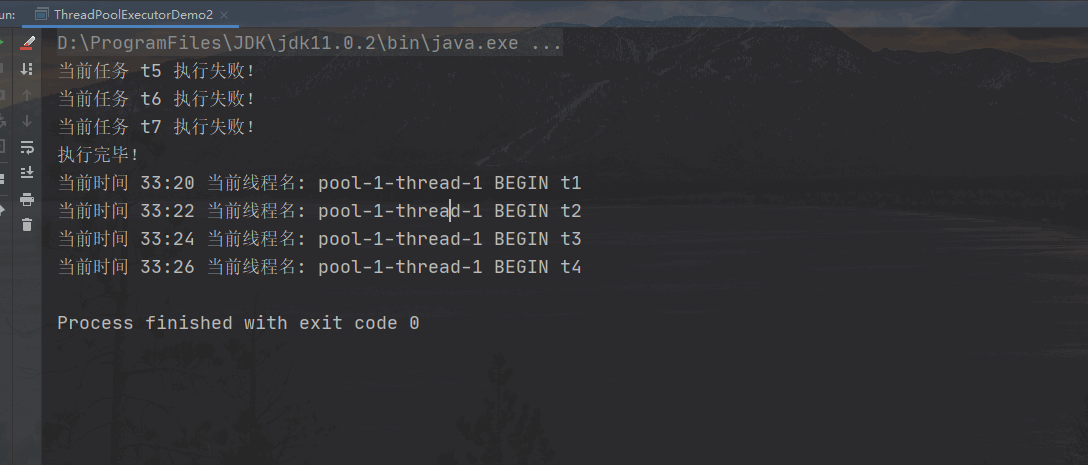1. 线程池的优势
- 节省资源开销:重复利用线程池中的线程,不需要每次都创建
- 提升对线程的管理能力:统一对线程分配和监控,避免无限创建,造成资源内存溢出和CPU耗尽
- 提高响应,降低系统开销:减少了创建线程的时间消耗,提高应对任务的响应
线程空间大小
线程空间大小和具体JDK版本有很大关系,JDK8将近1.9M、JDK11差不多1.5M多。具体大小的查看可以执行命令java -XX:+UnlockDiagnosticVMOptions -XX:NativeMemoryTracking=summary -XX:+PrintNMTStatistics -version。
1 | C:\Users\WONGS> java -XX:+UnlockDiagnosticVMOptions -XX:NativeMemoryTracking=summary -XX:+PrintNMTStatistics -version |
2. 几种常见线程池
newCachedThreadPool:数量无上限,该线程池会根据需要创建,但是优先使用之前构造的线程。这些池通常将提高执行许多短期异步任务的程序的性能,如果没有可用的现有线程,则将创建一个新线程并将其添加到池中。当60S内未使用的线程将被终止并从缓存中删除。 因此,保持空闲时间足够长的池不会消耗任何资源。
构造函数:
1 | public static ExecutorService newCachedThreadPool() { |
newFixedThreadPool:数量固定大小,该线程池重用在共享的无边界队列上运行的固定数量的线程。在任何时候,最多nThreads(构造函数的参数,核心线程数与最大线程数相等)个线程都是活动的处理任务。 如果在所有线程都处于活动状态时提交了其他任务,则它们将在队列中等待,直到某个线程可用为止。 如果在关闭之前执行过程中由于执行失败导致任何线程终止,则在执行后续任务时将使用新线程代替。 池中的线程将一直存在,直到明确将其关闭。
构造函数:
1 | public static ExecutorService newFixedThreadPool(int nThreads) { |
newSingleThreadExecutor:单线程,保证提交线程执行任务的FIFO, (但是请注意,如果该单个线程由于在关闭前执行期间由于执行失败而终止,则在需要执行新任务时将使用新线程代替。),在任何给定时间活动的任务不超过一个。与newFixedThreadPool不同,保证返回的执行程序不可重新配置为使用其他线程。
构造函数:
1 | public static ExecutorService newSingleThreadExecutor() { |
newScheduledThreadPool:该线程池可以安排命令在给定的延迟后运行或定期执行。
构造函数:
1 | public static ScheduledExecutorService newScheduledThreadPool(int corePoolSize) { |

通过类图,我们分析,其实 ScheduledThreadPoolExecutor 是 ThreadPoolExecutor 子类。
newWorkStealingPool:使用所有可用处理器作为目标并行度级别,创建工作窃取线程池,在实际中很少使用,不细讲。
综上所述,我们可以看到这些线程池底层实现都依靠 ThreadPoolExecutor 类的构造器,它是构造线程池的核心实现。但是现实在开发过程中避免利用 Executors 去创建线程池,这容易让人疑惑,JDK命名自带实现,为什么避免用,看完下一章节后,我们再谈这个话题。
3. 解析ThreadPoolExecutor
- corePoolSize:初始化大小,即使没有空闲,保留在池中的线程数,除非设置了allowCoreThreadTimeOut
- maximumPoolSize:允许线程池同时并行的线程数量
- keepAliveTime:当线程数大于内核数时,这是多余的空闲线程将在终止之前等待新任务的最长时间
- unit:TimeUnit类型,这没什么好说
- workQueue:在执行任务之前用于保留任务的队列,此队列将仅保存execute方法提交的Runnable任务。
- threadFactory:执行程序创建新线程时要使用的工厂
- handler:当线等待队列中的数量超过既定容量,所需要处理策略
构造函数:
1 | public ThreadPoolExecutor(int corePoolSize, |

3.1. corePoolSize、maximumPoolSize
corePoolSize、maximumPoolSize 线程池中初始化的线程数量,初始化太多或者太少,都有可能造成资源的浪费,具体实际情况根据所需要处理的任务特征决定。
3.2. workQueue
将待处理的任务放入一个队列,这是一个阻塞队列,该队列可以是有界也可以是无界。
3.3. handler
- AbortPolicy:拒绝执行处理程序,这是默认策略。
- CallerRunsPolicy:线程池未关闭,被拒绝任务,它直接在调用线程中运行被丢弃的任务
- DiscardOldestPolicy:丢弃最老,然后重试执行当前任务
- DiscardPolicy:比较粗暴,直接丢弃。
其实上述四种策略都不够友好,在实际应用场景中,肯定要记录日志或者通过RPC框架触发通知补偿措施,否则会造成数据丢失或者处理过程不够严谨。一般情况下,我们需要自己实现 RejectedExecutionHandler 接口,在接口中记录日志或者持久化不能处理的任务信息。再通过定时任务,进行补偿重试。
3.4. 线程池执行顺序

- 判断核心线程数(corePoolSize)是否已满,未满则创建核心线程,用来执行任务
- 判断 workQueue 队列类型是否是
有界队列,如果 否,则maximumPoolSize参数的配置无效;当是有界队列,则判断有界队列是否已满 - 判断
有界队列是否已满,当队列还有空间,还要进一步判定线程池是否已满即线程池中线程数量是否已达到maximumPoolSize,未超过则直接创建非核心线程;超过则根据拒绝策略执行相关操作
下面将举几个例子。
3.4.1. 无界队列样例
定义核心线程数,corePoolSize 为 1;无界队列LinkedBlockingQueue同时为展示更好的效果,我让每个线程执行后都sleep 秒钟。
1 | public class ThreadPoolExecutorDemo2 { |
通过控制台输出,我们可以看到,任务只在一个线程中有序执行,说明 maximumPoolSize 参数配置无意义,并未有创建线程的操作。
1 | 当前时间 35 当前线程名: pool-1-thread-1 BEGIN t1 |

3.4.2. 有界队列样例
定义核心线程数,corePoolSize 为 1;有界队列ArrayBlockingQueue 设置 3、同时为展示更好的效果,我也让每个线程执行后都sleep 秒钟。
任务数为 5,和maximumPoolSize设置 6 的情况下:我们看到 控制台打印显示有两个线程pool-1-thread-1和pool-1-thread-2。
1 |
|
任务数为 7,和最大线程池容量设置 1 的情况下:控制台打印有异常,这是因为我们任务数超出队列容量、最大线程池容量的之和,所以应用执行RejectedExecutionHandler策略。并且这时候应用状态时挂起,非常不友好,在下一节,写个案例自定义handler。
1 |
|

综上所述,在 有界队列实现中我们要注意,任务数 、 最大线程池容量、队列容量三者之间的关系。
3.4.3. 自定义handler
编写一个 Java类,实现接口 RejectedExecutionHandler,重写 rejectedExecution(Runnable r, ThreadPoolExecutor executor) 方法,具体如下
1 | public class CoustomRejectedExecutionHandler implements RejectedExecutionHandler { |
我们再运行下例子,我们可以发现并没抛出异常,而且控制应用也关闭。

3.5. 禁用Executors创建线程池
通过上面我们简单了解线程池的构造函数参数的意义,我们线程池再线程创建时,其构造函数中指定的队列 LinkedBlockingQueue,这是一种无界的队列,最大值 Integer.MAX_VALUE 即214748364,这队列堆积数量过大,在实际生产中可能直接OOM,不信的话。好奇同学也会说不是还有 newCachedThreadPool,但是它的最大线程数量是 Integer.MAX_VALUE,道理一样,容易造成OOM。
所以很多大型公司在编码规范上都禁止利用 Executors创建线程池。
3.6. 第三方常见创建线程池的方式
3.6.1. 引入 commons-lang3 包方式【不推荐】
1 | ThreadFactory threadFactory = new BasicThreadFactory.Builder().namingPattern("schedule-pool-%d").daemon(true).build(); |
- 依然给最大线程池赋值无上限。
- DelayedWorkQueue 延迟阻塞队列,不推荐
3.6.2. 引入 com.google.guava 包方式【一般推荐】
1 | ThreadFactory threadFactory = new BasicThreadFactory.Builder().namingPattern("schedule-pool-%d").daemon(true).build(); |
4. 常见问题
4.1. newFixedThreadPool(1) 与 newSingleThreadExecutor 区别
newSingleThreadExecutor采用FIFO,保证线程执行顺序,先提交的任务先执行,而newFixedThreadPool(1)不保证。在
newSingleThreadExecutor方法中,当线程执行出现异常时,它会重新创建一个线程替换之前的线程继续执行,而newFixedThreadPool(1)不行。